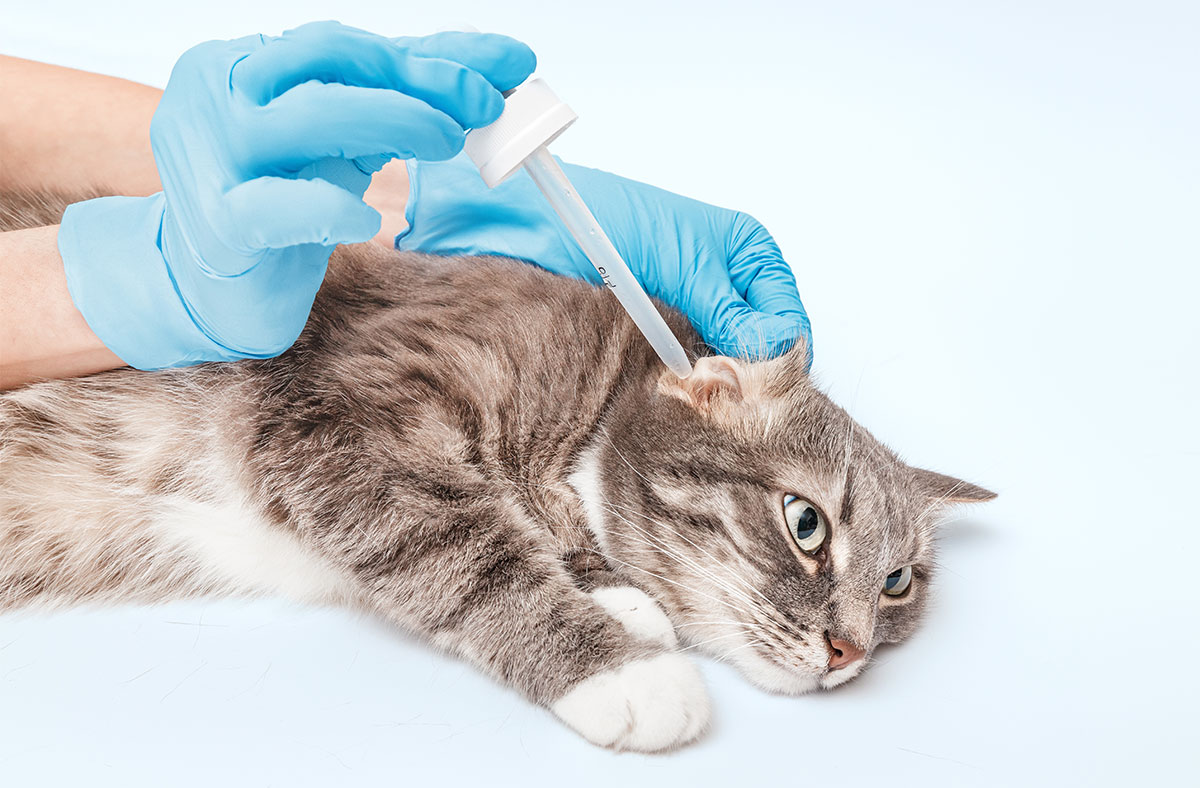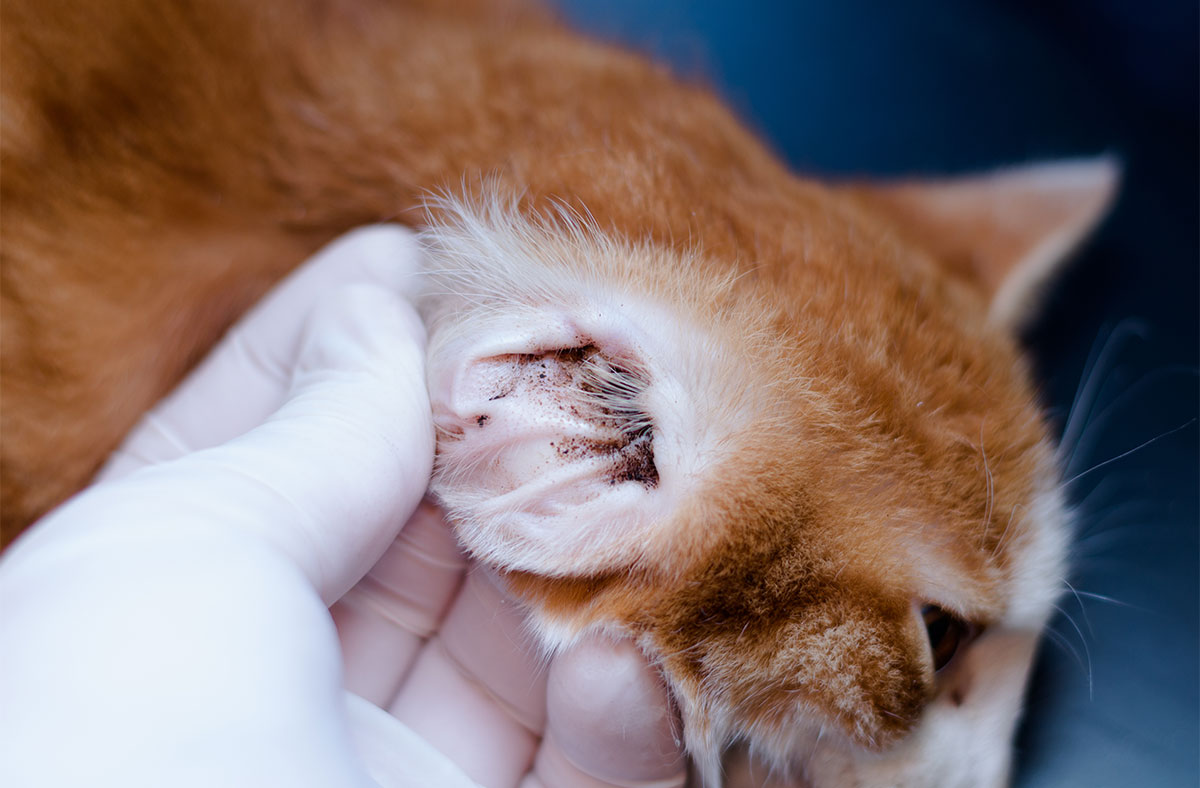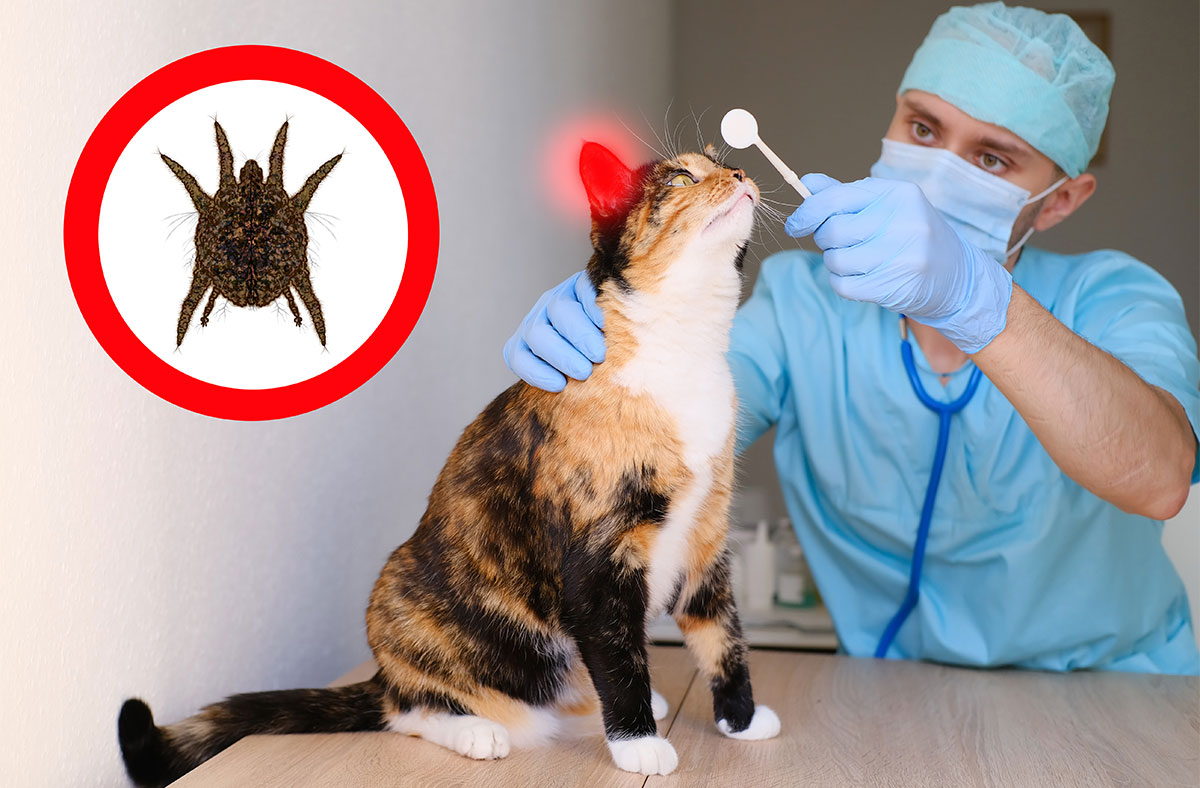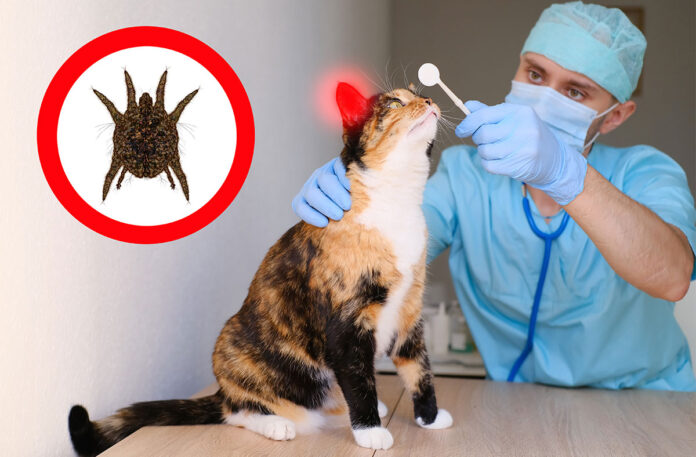Ear mites are extremely small parasitic mites, also known as Otodectes cynotis, which can infect the ears of cats. These mites are contagious, and they survive by ingesting nutrition from the cat’s ear tissues and blood. They may also live periodically on the cat’s paws and fur. They can be spread between cats and dogs, but they cannot live on humans for long periods of time.

Symptoms of Ear Mites
The most common clinical signs of ear mites include periodic to constant head shaking and scratching of the ears in an effort to relieve the intense itching that these parasites cause. The ears may also look inflamed and red, and there may be sores around the ears caused by continual scratching. A large amount of dark wax build-up may also be present in the ear, and the ear may have an unpleasant odor.
Diagnosing Ear Mites in Cats
Ear mites are diagnosed by taking a sample of the wax within the ear and examining it under the microscope. If ear mites are present, they can normally be seen microscopically in the wax of the pet’s ears. In some cases ear mite eggs can be seen.
Treating Ear Mites
Treatment for ear mites includes anti-parasitic medications that only need to be applied to the ears once after the ears are thoroughly cleaned. Topical treatments such as Revolution and Advantage Multi contain an ingredients called selamectin and moxidectin, respectively, which will eventually control the ear mite problem. Due to the fact that ear mites are contagious, all animals in the home should be treated to prevent re-infection regardless of whether or not they are showing symptoms. In cases where secondary bacterial infections have developed in the ear as a result of ear mites, ear medications containing antibiotics may be prescribed to clear the infection.
Outlook for Cats with Ear Mites
The prognosis for ears mites is excellent. In extremely severe cases of ear mites that have been present for a long time, scaring around the ear or the formation of ear hematomas may occur. In very severe cases structures within the ear may become damaged.
Preventing Ear Mites in Cats
To prevent ear mites in cats, it is important to thoroughly treat any previous cases, and to treat all animals in the household if an ear mite infection occurred in one of the pets. Ear mite prevention may also be achieved by using topical flea treatments such as revolution or frontline.
Preventing Ear Mites in Cats
Ear mites are tiny little mites, and they not only live in cats’ ears but they can also survive on a cat’s hair coat and bedding. If one cat in the household has had an incidence of ear mites, all pets should be treated because these mites are contagious to pets. The house should be thoroughly cleaned and vacuumed, and the pets’ bedding and toys should be washed in hot water and detergent. To ensure that additional outbreaks of ear mites do not occur, it is important to follow the treatment instructions provided by a veterinarian.
Medication
Topical flea treatments such as revolution and frontline may also be used to prevent ear mites in cats. Revolution is prescribed as a treatment for ear mites, but it may also help to reduce future incidences. Frontline is not prescribed for ear mite treatment, but it is often used as an ‘off label’ medication for ear mite treatment and prevention. An ‘off label’ use of a medication means that the product is not prescribed for the condition, but that veterinarians have found it to be effective in their own practices.
Periodically looking inside your pets’ ears, and watching out for symptoms of ear mites, may also help you to catch an ear mite outbreak early before it begins to affect all animals in the household.
Symptoms of Ear Mites in Cats

Symptoms of ear mites in cats can range from mild ear irritation to constant itching, scratching, and head shaking. In most cases, ear mite infection will also cause thick dark wax buildup and debris in the ears.
Symptoms of Ear Mites in Cats
Some cats are extremely sensitive to ear mite infection and they may have an intense reaction to even a mild case. These cats often have symptoms which include constant head shaking, scratching at the ears, and rubbing the ears with their paws. The ears may also acquire a constant tilt down or to the side. With time, constant scratching will lead to hair loss around the ears and the formation of ear hematomas where the tissue in the ears separate and blood begins to collect in the open pockets.
Other cats can have severe ear mite infections, but they have almost no symptoms. However, whether or not a cat reacts to ear mite infection with continual itching, ear mites will cause a drastic buildup of dark was and debris to occur in the ears. The excessive wax is due to the ear mites’ effect on the inside of the ears. As the movement of the mites irritates the sensitive lining of the ears, the ear responds by producing more wax in order to protect the ear.
If ear mites are not treated, secondary infections can occur in the ear. These infections can include yeast infections and skin infections that occur as a result of constant scratching around the ear. Most pet owners will notice these infections as a foul odor coming from the ear, blood and puss around and in the ear, and areas in and around the ear that are red and inflamed.
Treating Ear Mites in Cats

When a cat becomes infected with ear mites, the mites will quickly begin reproducing and increasing in number within the cat’s ears. The entire life cycle of the ear mites, from hatching out of the egg to maturing into a reproducing adult, takes only three weeks. Prompt treatment is necessary to prevent permanent damage from occurring and to relieve the cat from the intense itching that the mites cause.
Treating Ear Mites
While there are many over-the-counter treatments available that can be used to treat ear mites in cats, a prescription treatment from your veterinarian is best. Over-the-counter treatments often take weeks to eliminate the ear mite population, and cats do not like to have medication applied to their ears on a daily basis. Additionally, a veterinarian will be able to confirm if a cat is indeed suffering from ear mites, or if another medical condition is causing the symptoms.
Two products, Acarexx and Milbemite, are prescription ear mite treatments that are directly applied to the cat’s ears. In most cases these treatments only need to be applied once to eliminate the ear mites. Prescription products that are applied to the cat’s skin to eliminate ear mites include Revolution and Advantage Multi. Revolution is also used to kill intestinal worm and flea infestations in cats, and Advantage Multi is used to kill flea infestations; both of these products contain an added ingredient to address ear mite infections.
Ear mite infections are easily spread between other pets in the household. For those with multi-pet households, all animals will need to be treated for ear mites even if only one animal is showing symptoms. Otherwise the mites can continue to be passed back and forth and re-infect treated pets.

